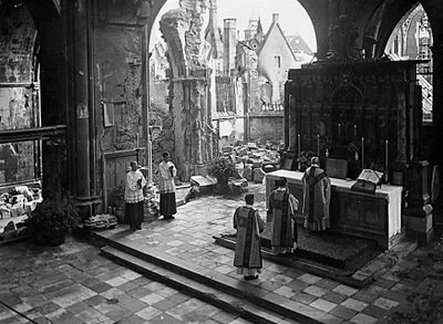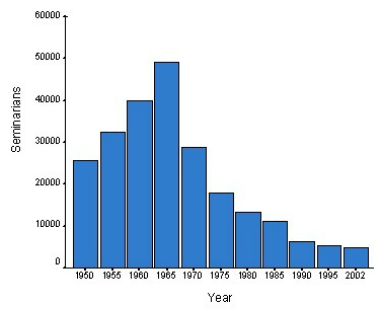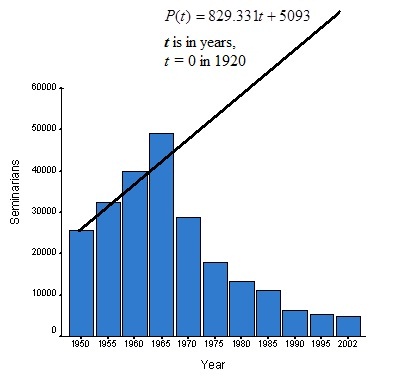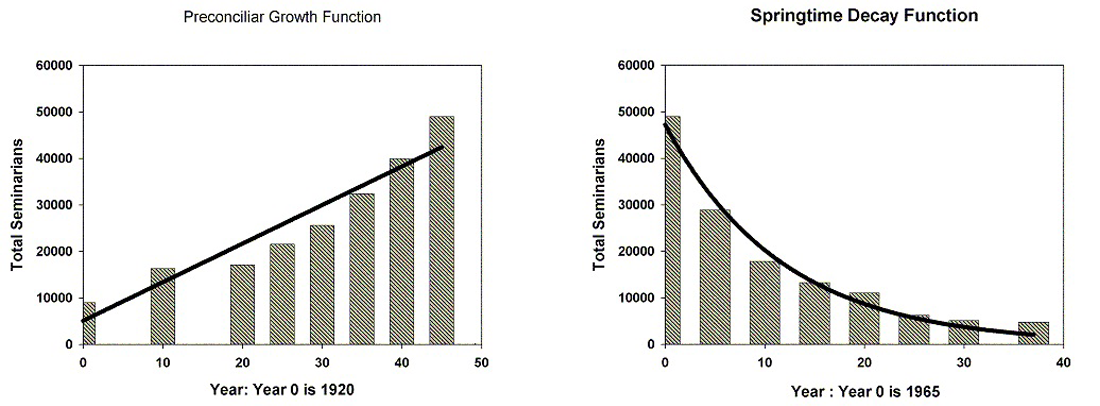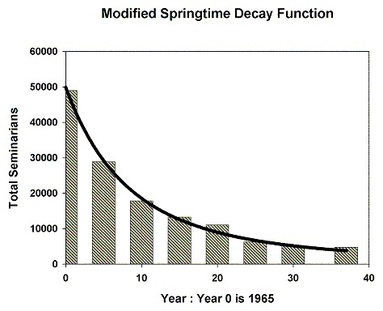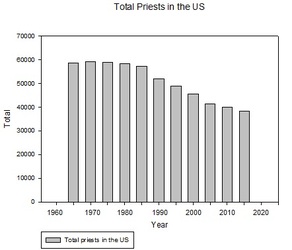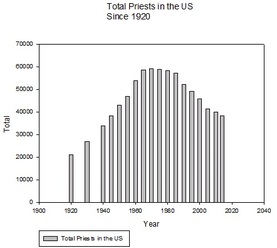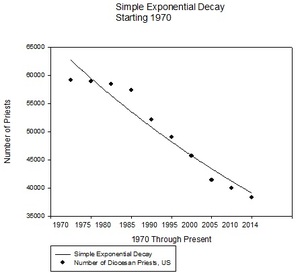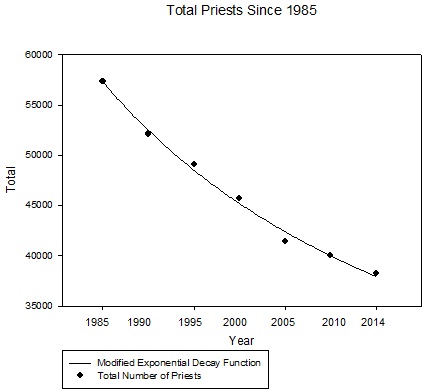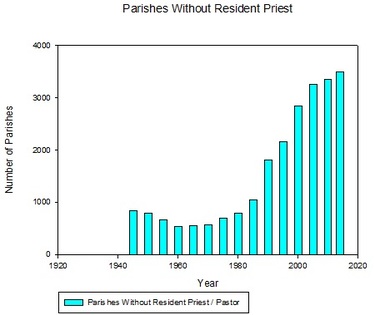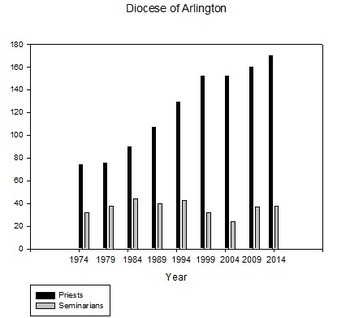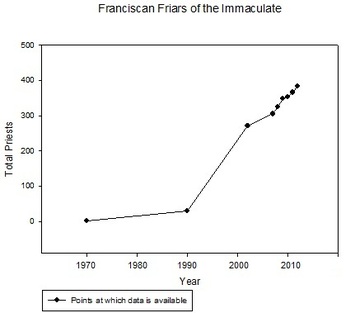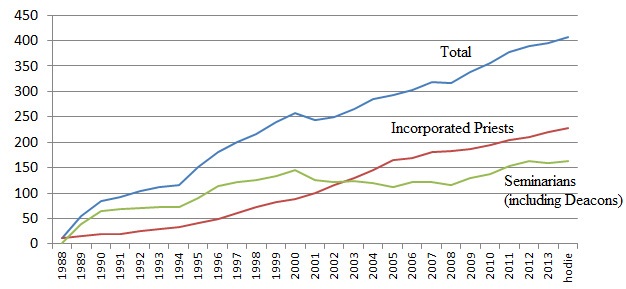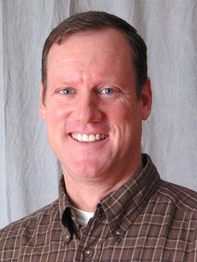Assuredly, the word of truth can be painful and uncomfortable. But it is the way to holiness, to peace, and to inner freedom. A pastoral approach which truly wants to help the people concerned must always be grounded in the truth. In the end, only the truth can be pastoral.
The Priest Shortage, A Manufactured Crisis?
Christendom Restoration Society presents a critical analysis of the crisis of the shortage of priests in the United States. With few exceptions, this serious crisis exists in varying degrees in most Catholic regions throughout the world. While reading this study, bear in mind that the results are not adjusted for population growth. Such adjustment would yield even more disastrous results.
The focus of this study is on the crisis of the decline in the numbers of seminarians and priests. Nevertheless, due to the essential and intimate connection between the priesthood and all of Catholic life, both from a practical and supernatural point of view, it is more than reasonable to suspect that the results of a study of all areas of Catholic life would display a similar exponential decay function which we find in the decline of the priesthood. The consequences of the last fifty years go way beyond Catholic communities and affect all of humanity both in practical terms and supernaturally.
Consider, for example: the steep decline in the sacramental lives of souls, of baptisms, confirmations, weddings, along with the increase in cohabitation, serial monogamy, and broken families. The moral decay parallels the decline in Catholic vocations. Consider the number of parishes and schools closing and parishes without a priest. Consider the incredibly low average level of knowledge of the Catholic Faith that exists amongst most all Catholics today including the clergy. What if the various religious orders were still available to instruct us? What if the sisters who used to run hospitals were still there for our troubled inner cities? Does anyone wonder why it all began about the same time?
Our challenge to the reader is to be realistic. The picture of the future is not bright and indeed can be overwhelming. But as Catholics we know that we must persevere in Faith, Hope, and Charity confident that God is indeed in charge and we need only to do our very best to align our freewill to His, praying to Him through the intercession of the Most Blessed Virgin Mary. A quote that gives me consolation in times of desolation is that of St. Padre Pio, “Pray, Hope, and Don’t Worry!”
The study below asks us to engage our hearts and minds beginning, as always, with prayer. To begin, we recommend prayers of reparation to the Most Sacred Heart of Jesus. We suggest you consider as an option a small booklet with the Imprimatur of His Excellency Edward James Slattery, Bishop of Tulsa, OK. entitled:
An Analysis of the "Shortage of Priests" as Self-imposed by the Catholic Church
by David Sonnier
I. Introduction
Every Fall semester in my introductory programming class the students get a programming assignment involving “information visualization.” They write a program that involves taking a set of data that represents “total enrollment of students in a network of universities” in five year increments from 1920 through the present, and generating a bar chart depicting the data graphically. The students do this by using graphics objects, mostly just rectangles and lines. Their program reads a file containing “enrollment data”, and portrays it, in a loop, as a series of rectangles from left to right. I let them make all decisions regarding style, color, text font, etc., but they are to display the data using some general principles for effective visualization of numeric data. The successful product typically looks like one of the images in Figure 1 below, showing a slow, steady increase from 1920 to 1965 followed by a steep decline from 1965 to the present.
Other than the students who are having some difficulty getting the program to run, they usually have comments such as:
“Something went wrong in 1965.”
“They made some bad decisions somewhere around 1965”
“Did they eliminate football in 1965?”
Although I don’t normally reveal the source of the data set, it is the total enrollment of seminarians throughout the U.S. from 1920 to the present. [1] The students, uninhibited by preconceived notions and unencumbered by ideology, are willing to acknowledge the point at which something went wrong, that it was due to internal, not external factors, and that, in fact, something actually has gone wrong.
II. Background
The fathers of the Second Vatican Council met from 1962 to 1965 to engage in a spiritual renewal of the Church, and to find a way to bring the Gospel to people throughout the world by updating the Church to the modern world. From the start there was great emphasis placed on reform of the liturgy, despite the fact that many aspects of the proposed ecclesiastical “reform” had been previously condemned by previous Popes such as Gregory XVI and St. Pius X (cf. Mirari Vos and Pascendi Dominici Gregis).
One might think that the much-touted “renewal” in Catholic life ushered in by the Second Vatican Council would have significantly increased the number of priestly vocations. The statistical analysis of data seems to present a drastically different picture. When one expresses concern over the sudden loss of vocations they are answered with assurances that “it’s only temporary,” and “we’re no longer in decline.” It is impossible to reconcile these reassurances with the reality of the situation. Vocations have dwindled to a near-halt in one formerly Catholic region after another. In Ireland a record low of 12 young men entered seminary in 2012. [2] In Belgium only 14 priests were to be ordained in 2014, and in Corsica there is just one young man preparing for ordination. [3]
What can we learn from the situation at this point? It will be the aim of this paper to gain a better understanding of the current state of affairs using the available statistics.
III. Data and Methodology
CARA (Center for Applied Research in the Apostolate) provides some statistics for public consumption, but they only show data subsequent to 1965/1970. [4] With the 2003 publication of Ken Jones' Index of Leading Catholic Indicators, the picture becomes quite clear for those who are willing to see. [1] The113-page paperback book containing statistics relating to all aspects of Catholic life: Catholic education, religious orders, Catholic practice and belief, seminarians, nuns, and diocesan priests going back to 1920. Jones provides us with the data prior to 1965 so that we can compare the trends prior to 1965 with those following 1965. Using primarily these two sources, we take irrefutable, unbiased, and undeniable raw data pertaining to the past and current situation in the Church, and present some analysis of that data.
IV. Indicators
a. Seminarians in the U.S.
Arguably, data depicting the total number of seminarians throughout the better part of the last century is the most significant set of data for understanding the future of the Catholic Church in the United States. The data for figures 3 through 5 comes from Leading Catholic Indicators. CARA does not have public data concerning the total number of seminarians, just “graduate level seminarians” since 1965. Figure 2 represents the total seminarians from 1950 to 2002.
Figure 3 seems to indicate that there are essentially two functions: one linear and one exponential. The period prior to 1965 shows a linear increase and the period from 1965 to the present shows an exponential decrease.
(1) Prior to 1965: Linear Growth Function
The graph for the period prior to 1965 exhibits a period of steady growth, so it was discovered that a linear regression of these four data points could be approximated with a line of slope 829.3, implying that each year between 1920 and 1965, there were approximately 829 seminarians more than there had been the previous year. So every ten years there were approximately 8,293 seminarians more than there had been the previous decade.
The growth rate over this period can be expressed as P (for "Preconciliar Growth Rate") as a function of time t, where t is in years and t = 0 in 1920:
P(t) = 829.33t + 5093
Or, expressed as a function of the year:
(2) Post 1965: Exponential Decay Function
It is clear that the period from 1965 onward is nonlinear, so a different technique is required for modeling this period. The exponential decrease from 1965 onward appears similar to a graph of radioactive decay; as it turns out, this period can be modeled by what is commonly called an exponential decay function. Since this period of the Church has been often called the "New Springtime," referring to a glorious era of the Church that was predicted to occur as a result of the Council, we shall refer to this function as the Springtime Decay Function S(t), where S, the Springtime Decay, is a function of time t. We begin by taking the log of each of the data points. This gives us an essentially linear data set, to which we can match a line as we did previously for the Preconciliar Growth Function. Now we exponentiate both sides of our equation obtaining the following function:
Or, expressed as a function of the year:
Figure 4 shows both the preconciliar growth function and the springtime decay function side by side:
Applying this model we find that by the year 2065, 100 years from the beginning of the Springtime Decay process, there will be a total of 10 seminarians in the United States. The half-life of this process is 8.19 years, the approximate period of time it takes for the number of seminarians to diminish by ½.
The last two actual data points do not fit the model well, as they are above the exponential decay function. Certainly, according to some, this means that the decline is over, and that all will be back to normal soon. This is wishful thinking, but to provide a more accurate model, we turn to the modified exponential decay model. The Modified Springtime Decay Function is not as simple, but it is more accurate:
Or, expressed as a function of the year:
According to this modified decay function there will be 779 seminarians in the year 2065 instead of the 10 predicted using the previous model. The difference between this and the previous model is that it has a non-zero asymptote, meaning that the number of seminarians in the United States would eventually converge to 78 rather than zero.
b. Lost Vocations
One can obtain a rough estimate of the number of lost vocations by taking the sum from 1965 to the year 2000, in five year increments, of the difference between P(year) and S(actual), where the values for S come from the actual data in Jones' "Total Seminarians" table.
This estimate makes two assumptions:
- For each of the five year increments the "number of seminarians" represents a distinct set of individuals. For example, the 28,819 seminarians in 1970 are not the same individuals as the 17,802 seminarians in 1975.
- P represents the number of seminarians that would have existed had the Preconciliar Growth Rate still been in effect. S represents the actual number.
According to this rough estimate, approximately 17,741 vocations were lost over the first five-year period, 32,904 were lost over the second five-year period, etc., for a total of 327,746 from 1965 to 2002.
I have no formula for the calculation of the number of Catholic souls lost as a consequence of this many potential priests never ordained.
c. The Priesthood in the U.S.
It quite naturally follows that following from this sudden precipitous decline in seminary attendance there is a gradual decline in the number of priests throughout the U.S. This trend began slowly in the aftermath of Vatican II and continues through the present. The data currently available from CARA, in their “frequently asked questions” section can be used to produce a bar chart, the bleak picture in Figure 6. The data representing the dwindling number of clergy in the US defies a simple analysis. First it must be viewed as part of a larger trend, and to do so we go back to the 1920 population, and use data extracted from Leading Catholic Indicators. The picture becomes clear when compared with the data from the 40-50 previous years (Figure 7).
Whereas the graph of the number of seminarians (Figures 1-5) peaked sharply at 1965, the graph reflecting the number of ordained clergy we see a delayed peak, and a very gradual decline beginning approximately at year 1970. Using regression techniques to establish a simple exponential decay pattern, starting in 1970 we find a weak model which may provide misleading results, (Figure 8, Left) but we find a starting point for more realistic models which begins in 1985 (Figure 8, Right). Thus we can base our prediction on the function
Where t = 0 in 1985. Following the trajectory of this exponential decay model into the future to 100 years after the conclusion of the second Vatican council indicates that there would be approximately 26,651 priests in the US by then. A similar model using four-parameter logistic curve predicts a similar number, 27,421:
Although both models match the data within expectation, both models are flawed. All they have done is find a function that matches the data without giving consideration to the fact that the average age of the current population of priests is 63. [5] If the average priest is 63, the average priest is retiring soon. The drop will be more precipitous, but it is difficult to predict how much.
Figure 8
d. Parishes without a Resident Priest
Figure 9 depicts the number of parishes without a resident priest over the years, starting in 1945. It is quite clear that between the years 1945 and 1965 the number of such parishes was dwindling, and by 1960 it was as low as 546. In 1965 it was virtually the same, 549, which means that a mere 3% of all parishes didn’t have a resident priest. Today it is 3496 out of 17,483 parishes, which is approximately 20% of all parishes, or one out of five. Clearly, without dispute, the trend prior to 1965 was superior to that following 1965. The trend following 1965 continues. We can use linear regression over the period from 1970 to the present to find a simple linear model for prediction:
Where t=0 in 1970. Barring a radical change in course, by the year 2030 there will be approximately 4900 closed parishes in the U.S. Parish closures will become commonplace in most dioceses. A more elaborate, non-linear model predicts 4720 closed parishes in 2030. In either case there is clearly no improvement.
V. Analysis and Hypothesis
Of the four constitutions, nine decrees and three declarations produced by the fathers of the Second Vatican Council, the first document was the Constitution on the Sacred Liturgy, Sacrosanctum Concilium (SC). There has been a great deal of misunderstanding regarding SC and the intended results. This point is easily made by noting that nowhere in SC, or any other documents of Vatican II, are any of the following questions raised, discussed, or addressed in any way:
- Whether or not the Holy Sacrifice of the Mass is to be offered Ad Populum
- Whether the Faithful are to receive Communion in the hand or on the tongue
- Whether or not the laity can touch the sacred species with unconsecrated hands
- Whether Communion is to be received under both species
- Whether Communion is to be received kneeling or standing
- Whether or not the altar rails were to be removed
- Whether or not the Missal published in 1962 was to be forbidden
- Whether or not serving at the altar was to now be extended to girls/women
- Whether or not the revised Missal would be exclusively in the vernacular
While none of these questions were ever addressed anywhere in any documents of the Second Vatican Council, we do find this in the Constitution on the Liturgy: [6]
“…there must be no innovations unless the good of the Church genuinely and certainly requires them; and care must be taken that any new forms adopted should in some way grow organically from forms already existing.” (SC, 23)
In other words, none of these innovations should have even been considered seriously. There was no basis for any of them, and most of them had been previously condemned. According to Sacrosanctum Concilium the sacred liturgy is the “summit toward which the activity of the Church is directed; and at the same time, it is the fountain from which all her powers flow.” (SC, 10) Since this most intimate (and at the same time, visible) aspect of our Christian lives was subject to unlimited innovation, doesn’t it at least make some sense to assert that the sudden decline in vocations was a direct result of the radicalization of the liturgy? Yet, when one does so one is often accused of inappropriately associating causality between this sudden radicalization and the sudden loss of vocations (post hoc ergo propter hoc).
While unlimited innovation and experimentation was permitted after the conclusion of the Second Vatican Council, the one thing that was rarely permitted was “the experiment with tradition,” or openly permitting a diocese, an institute of apostolic life, or even a parish church to embrace a liturgy and spirituality of the type that was the norm prior to the Second Vatican Council. However universal the radical innovations may have once seemed, we now see that there were “pockets of resistance” where people, who we can now admire in the hindsight, knew their Faith well enough to resist the trendy new liturgical fads. Now that Summorum Pontificum is the law of the Church, such an “experiment with tradition” is possible, even common. We can not only see the results, we can quantify them.
I propose the following hypothesis: that the degree to which a diocese, a society of apostolic life, an institute, or even a parish Church adheres to the most traditional possible variation of the liturgy and doctrine corresponds to the degree to which we can witness vitality and spiritual life in these same dioceses, societies and institutes. This vitality can be estimated by the fruits of obedience to the Holy Church during a time of confusion: vocations, workers in the vineyard, and specifically priests.
VI. A Test of the Hypothesis
We should always ask whether a hypothesis can be tested. A proposition is of little use if it cannot be tested. Experiments should be duplicated to see if the same results are obtained every time. This is the only thing that will convince the skeptic, and since we can now quantify, we can discriminate among competing hypotheses.
Now that we have had the opportunity, what results do we find? We can view some of the statistics from those seminaries in which the 1962 rite is followed and priests are formed according to preconciliar standards. We can also view statistics from those dioceses in which the norm is a traditional and liturgical orthodoxy that reflects the Church prior to Vatican II.
a. Diocese of Arlington, Diocese of Lincoln:
Arguably the most damaging of innovations with the liturgy was the introduction of female altar servers. Initially condemned as a “very grave abuse of the liturgy” after Vatican II, it was subsequently tolerated, then finally following a mysterious sequence of events in the early 1990’s it was imposed in most U.S. dioceses. However, the Diocese of Arlington and Diocese of Lincoln both continued the practice of allowing only males to serve at the Holy Sacrifice of the Mass. Figure 10 shows the steady increase in priestly vocations over the past 40 years in the Diocese of Arlington. Statistics from the Diocese of Lincoln are similar, but complicated by the introduction of not one but two seminaries, one for the Diocese of Lincoln and the other for the Priestly Fraternity of St. Peter. Had every Diocese in the U.S. followed these wise examples, there would be no need for this case study.
b. Diocese of Ciudad del Este, Paraguay:
Under the leadership of a bishop who encouraged his priests to disassociate themselves from politics and instead go about the business of saving souls, and with a healthy application of the provisions of Summorum Pontificum, the Diocese of Ciudad del Este made amazing progress during the years from 2004 to 2014. As of July 2014, there were 250 candidates preparing for the priesthood in this diocese in which almost every parish offers a Mass in the Extraordinary Form.
During the past ten years:
The number of diocesan priests jumped from 14 to 83
The total number of priests went from 79 to 140
The number of marriages went from approximately 1200 to 6277
The number of Chapels of Perpetual Adoration went from 0 to 8
The number of Baptisms went from 9500 to 21556
The number of confirmations went from 46 to 146
Clearly such a diocese should be considered a model for every other diocese in both North and South America to emulate. Any diocese can take similar steps and reverse the decline within just a few years.
c. Franciscan Friars of the Immaculate:
The FFI were founded in the province of Avellino, Italy in 1970. In 1990, there were approximately 30 Friars, and they were erected as an institute of diocesan right. On 1 January 1998, Pope St. John Paul II elevated them to an Institute of Religious Life of Pontifical Right. They are present throughout the world, along with the Franciscan Sisters of the Immaculate. They have a special devotion to St Maximilian Kolbe. Following the landmark clarification of the status of what we now know as the Extraordinary Form of the Mass in 2007, Summorum Pontificum, they embraced the traditional Mass on a wide scale. It is clear that they have been successful in attracting vocations to the priesthood (at least up until last year.) [7]
d. FSSP:
The Priestly Fraternity of Saint Peter, established as a Society of Apostolic Life, which is a community of priests who do not take vows as religious, but who work together for a common mission. That mission is to spread the Gospel within the dioceses in which they are given permission by the local bishop, by the usual means (preaching, catechesis, youth education , etc.) but also by providing sacramental life according to the liturgical books of 1962. As of 2013 there were 407 of these priests, with an average age of 37. A rough projection of the total number of priests, based on the numbers depicted in Figure 12, is provided by a linear model with a slope of 16.28. According to this model there will be 520 priest by 2020, and 682 priests by 2030. Although this does not provide any immediate remediation, it should help provide a sense of direction.
Figure 12 (Source: http://www.fssp.org/en/chiffres.htm)
VII. Conclusion
Several things become evident with this brief analysis:
Several things become evident with this brief analysis:
- That the decline in priestly vocations did, in fact, begin with the chaotic implementation of Sacrosanctum Concilium. As a result of Summorum Pontificum (2007, Benedict XVI) it is possible to openly embrace a liturgy and spirituality of the type that was the norm prior to the Second Vatican Council. We can witness the results of such an “experiment with tradition” and contrast them with the results of the many other unfortunate experiments of the past forty years. When a diocese, a society of apostolic life, an institute, or a parish adheres to the most traditional possible variation of the liturgy and doctrine, the post-Vatican II decline goes into remission and is soon replaced by a steady growth in vocations.
- That this wound is self-inflicted. The radicalization of the liturgy (and consequential confusion and decline in vocations) was not imposed by external forces. To attempt to assign blame would go beyond the scope of this study; let us agree that it was imposed by Catholics. The persecution of those who resisted radical innovation is well documented, but also beyond the scope of this study. It deserves to be mentioned, however, that it seems that the persecution continues to this day. During the last two years we have witnessed the purging of the leadership of the Franciscan Friars as well as that of the Diocese of Ciudad del Este, for example. No good reason has been provided in either case, and loyal Catholics watching these travesties of justice have been scandalized.
- That the crisis continues. Figures 5 through 9 graphically underscore this conclusion.
The loss of vocations is beyond our human ability to comprehend, since it involves souls, but Catholics should at least be honest about the situation and attempt to comprehend it. Once we comprehend it we are morally obligated to do something about it, whether that means praying, fasting, or taking appropriate action according to our state of life.
Pope Benedict XVI comments on the present state of our liturgy in the Preface to The Spirit of the Liturgy:
“In fact, it is threatened with destruction, if the necessary steps are not taken to stop these damaging influences… [W]hat is imperative is a new reverence in the way we treat it, a new understanding of its message and its reality, so that rediscovery does not become the first stage of irreparable loss.
My purpose in writing this little book… is to coincide with what Guardini wanted to achieve in his own time with The Spirit of the Liturgy… If this book were to encourage, in a new way, something like a ‘liturgical movement’, a movement toward the liturgy and toward the right way of celebrating the liturgy, inwardly and outwardly, then the intention that inspired its writing would be richly fulfilled.” [8]
The analysis in this paper provides actual data and interpretation of that data so that we can see the irrefutable truth in the words of Pope Benedict XVI. The words “threatened with destruction” are not empty rhetoric. This threat is real. We can see the Hand of God in the decline of certain institutes, societies, and dioceses, as their decline follows a pattern that is commonly found in nature. Whenever we find an exponential decay function in nature it is typically in conjunction with the death or decay of some entity within His creation. The death of institutes, dioceses and societies throughout the Church in the West is imminent, barring an immediate reversal.
At the time Pope Benedict wrote The Spirit of the Liturgy the “liturgical movement” he mentioned was already in its embryonic stages. In the past fifteen years we have seen it grow, develop and flourish. Young men have been inspired by “the right way of celebrating the liturgy,” and abandoned the world for the priesthood, as young men have always done. It is clear that God calls men to the priesthood; His doing so within religious communities that adhere to tradition and orthodoxy seems to be a good indication that He looks favorably upon them and the work that they are doing.
ENDNOTES
[1] Index of Leading Catholic Indicators: The Church Since Vatican II, Kenneth C. Jones. Oriens Publishing Company, St. Louis, Missouri.
[2] “Irish Priestly Vocations in Worrying Decline,” Catholic World Report, October 3 2012.
[3] Summarized from Rorate Caeli Blog, (http://rorate-caeli.blogspot.com) with original sources at La Libre Belgique, 22 August 2014 and Riposte Catholic, 23 August 2014)
[4] cara.georgetown.edu
[5] “US Catholics Face Shortage of Priests”, USA TODAY, May 2014, Dave Breitenstein.
[6] Constitution on the Sacred Liturgy Sacrosanctum Concilium, Solemnly Promulgated by Pope Paul VI on December 4, 1963.
[7] Ecclesia Dei Delft, www.ecclesiadei.nl
[8] The Spirit of the Liturgy, Pope Benedict XVI (Joseph Cardinal Ratzinger), trans. by John Saward, San Francisco: Ignatius Press, 2000, pp. 8-9.
[1] Index of Leading Catholic Indicators: The Church Since Vatican II, Kenneth C. Jones. Oriens Publishing Company, St. Louis, Missouri.
[2] “Irish Priestly Vocations in Worrying Decline,” Catholic World Report, October 3 2012.
[3] Summarized from Rorate Caeli Blog, (http://rorate-caeli.blogspot.com) with original sources at La Libre Belgique, 22 August 2014 and Riposte Catholic, 23 August 2014)
[4] cara.georgetown.edu
[5] “US Catholics Face Shortage of Priests”, USA TODAY, May 2014, Dave Breitenstein.
[6] Constitution on the Sacred Liturgy Sacrosanctum Concilium, Solemnly Promulgated by Pope Paul VI on December 4, 1963.
[7] Ecclesia Dei Delft, www.ecclesiadei.nl
[8] The Spirit of the Liturgy, Pope Benedict XVI (Joseph Cardinal Ratzinger), trans. by John Saward, San Francisco: Ignatius Press, 2000, pp. 8-9.
David L. Sonnier is an Associate Professor of Computer Science at Lyon College in Batesville, Arkansas, and a retired Lieutenant Colonel in the United States Army and serves on the Board of Christendom Restoration Society. Other works by David Sonnier include:
- “Ecclesiastical Aggiorniamento and Exponential Decay Functions: A Statistical Analysis” with Albert P. Marcello III, 2004.
- "Gender-Bender Liturgy and the Decline of Vocations," Christian Order, Volume 44, Number 12, December 2003.
- “Springtime Decay,” on www.seattlecatholic.com, January 2004.
- “Child Molestation by Homosexuals and Heterosexuals,” Homiletic and Pastoral Review, May 2005, p. 44-54.
Closing Comments:
This study included The Priestly Fraternity of St. Peter and the Franciscan Friars of The Immaculate as examples of priestly communities that adhere to a traditional orientation. There are numerous other such priestly communities, many of which are not at this time present in the United States, as well as numerous religious and monastic communities of both men and women. Below is a sample listing of some of the major / international priestly communities. While the drama between them and the Vatican is ongoing, as a matter of justice, we include the Fraternal Society of St. Pius X, founded by the French Archbishop, His Excellency Marcel François Marie Joseph Lefebvre who - along with His Excellency Antônio de Castro Mayer of Campos, Brazil, a few scattered parishes, and other communities and individual priests - always maintained that the Traditional Latin Mass was never abrogated. In 2007, nearly 38 years after the introduction of the Novus Ordo Missae, they were exonerated with the release of His Holiness, Pope Benedict XVI's Summorum Pontificum. Is it not unreasonable, given the extreme crisis in the church, to wonder: "What else might Monseigneur Lefebvre have been right about?"
© 2011 - 2015 Christendom Restoration Society, Inc.
All Rights Reserved
This study included The Priestly Fraternity of St. Peter and the Franciscan Friars of The Immaculate as examples of priestly communities that adhere to a traditional orientation. There are numerous other such priestly communities, many of which are not at this time present in the United States, as well as numerous religious and monastic communities of both men and women. Below is a sample listing of some of the major / international priestly communities. While the drama between them and the Vatican is ongoing, as a matter of justice, we include the Fraternal Society of St. Pius X, founded by the French Archbishop, His Excellency Marcel François Marie Joseph Lefebvre who - along with His Excellency Antônio de Castro Mayer of Campos, Brazil, a few scattered parishes, and other communities and individual priests - always maintained that the Traditional Latin Mass was never abrogated. In 2007, nearly 38 years after the introduction of the Novus Ordo Missae, they were exonerated with the release of His Holiness, Pope Benedict XVI's Summorum Pontificum. Is it not unreasonable, given the extreme crisis in the church, to wonder: "What else might Monseigneur Lefebvre have been right about?"
Personal Apostolic Administration of St. John-Marie Vianney (Brazil only)
JHF
© 2011 - 2015 Christendom Restoration Society, Inc.
All Rights Reserved
- Log in to post comments

